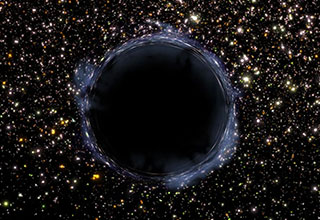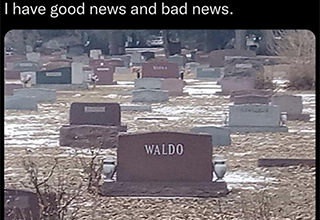20 Fascinating Black Hole Facts
Carly Tennes
Published
07/10/2024
in
wow
Though NASA may have given black holes the superlative of being some of "the most mysterious cosmic objects" in our universe, they're not just ominously lurking vacuums ready to slurp us into the abyss — though that's definitely a part of it. Since their first proposal in the 16th century, scientists have been fascinated by these entities, doing their best to understand how they work, why they exist, and what, exactly, is on the other side.
From the terrifying definition of "spaghettification” to the dangers possibly lurking in our own solar system, here are 20 massive black hole facts to yank you in.
- List View
- Player View
- Grid View
Advertisement
-
1.
 “In ‘Interstellar’ the depiction of a black hole required completely new CGI rendering software and was so accurate that it provided enough … insight to publish three scientific papers.”
“In ‘Interstellar’ the depiction of a black hole required completely new CGI rendering software and was so accurate that it provided enough … insight to publish three scientific papers.” -
2.
 “Wi-Fi was developed by using technology from a failed experiment attempting to detect mini black holes.”
“Wi-Fi was developed by using technology from a failed experiment attempting to detect mini black holes.” -
3.
 “If you shout or make a sound that is 1,100 dB, it will create a black hole destroying our galaxy.”
“If you shout or make a sound that is 1,100 dB, it will create a black hole destroying our galaxy.” -
4.
 “The process of getting torn apart by a black hole is called Spaghettification.”
“The process of getting torn apart by a black hole is called Spaghettification.” -
5.
 “A hypothetical black hole with a size of just 0.2 millimeters (1⁄127 inch) would have the same mass as the Moon.”
“A hypothetical black hole with a size of just 0.2 millimeters (1⁄127 inch) would have the same mass as the Moon.” -
6.
 “Before the Large Hadron Collider (LHC) was completely constructed, there were concerns among the public that its high-energy experiments would lead to the formation of micro black holes or strangelets, a dark-matter-like particle that can convert all matter it touches into strange matter.”
“Before the Large Hadron Collider (LHC) was completely constructed, there were concerns among the public that its high-energy experiments would lead to the formation of micro black holes or strangelets, a dark-matter-like particle that can convert all matter it touches into strange matter.” -
7.
 “The black hole TON 618 is a very bright object in space that is located near the border of two constellations. It has one of the most massive black holes ever found and is as bright as 140 trillion suns. It’s located very far away from Earth, about 18.2 billion light-years away.”
“The black hole TON 618 is a very bright object in space that is located near the border of two constellations. It has one of the most massive black holes ever found and is as bright as 140 trillion suns. It’s located very far away from Earth, about 18.2 billion light-years away.” -
8.
 “In 2011, astronomers discovered the largest and farthest reservoir of water ever detected in the universe. The water, equivalent to 140 trillion times all the water on Earth, surrounds a huge black hole more than 12 billion light-years away.”
“In 2011, astronomers discovered the largest and farthest reservoir of water ever detected in the universe. The water, equivalent to 140 trillion times all the water on Earth, surrounds a huge black hole more than 12 billion light-years away.” -
9.
 Contrary to popular misconception, our sun isn't actually large enough to become a black hole.
Contrary to popular misconception, our sun isn't actually large enough to become a black hole. -
10.
 “Small black holes are more violent than supermassive ones: the tidal forces at the event horizon gets substantially weaker the larger the black hole—you can theoretically survive a trip beyond the point of no return without being crushed.”
“Small black holes are more violent than supermassive ones: the tidal forces at the event horizon gets substantially weaker the larger the black hole—you can theoretically survive a trip beyond the point of no return without being crushed.” -
11.
 “Some theoretical physicists believe that black holes create ‘baby universes’ on the ‘other side.’”
“Some theoretical physicists believe that black holes create ‘baby universes’ on the ‘other side.’” -
12.
 “If you watched an object slip into a black hole, no matter how long you watched, you would never actually see the object enter it due to time dilation.”
“If you watched an object slip into a black hole, no matter how long you watched, you would never actually see the object enter it due to time dilation.” -
13.
 “Black holes in space were named after the Black Hole of Calcutta, an infamous dungeon in India where prisoners died of suffocation and heat exhaustion.”
“Black holes in space were named after the Black Hole of Calcutta, an infamous dungeon in India where prisoners died of suffocation and heat exhaustion.” -
14.
 “The idea of black holes was first proposed in 1783 by John Michell, calling them ‘dark stars’ and proposing a method to detect them by looking for star systems that showed the gravitational effects of two stars, but only one star was visible, which is indeed how scientists look for them today.”
“The idea of black holes was first proposed in 1783 by John Michell, calling them ‘dark stars’ and proposing a method to detect them by looking for star systems that showed the gravitational effects of two stars, but only one star was visible, which is indeed how scientists look for them today.” -
15.
 Due to the fact that we can’t see black holes, there is an unlikely — but non-zero — chance that there is a black hole in our solar system right now.
Due to the fact that we can’t see black holes, there is an unlikely — but non-zero — chance that there is a black hole in our solar system right now. -
16.
 “Supermassive Black Holes also have a habitable zone where planets can form.”
“Supermassive Black Holes also have a habitable zone where planets can form.” -
17.
 “The lowest sound ever recorded is 57 octaves below middle-C and is from a black hole in the Perseus Cluster.”
“The lowest sound ever recorded is 57 octaves below middle-C and is from a black hole in the Perseus Cluster.” -
18.
 “The merging of two black holes in 2015 emitted 3.6 septillion yottawatts of power, greater than the combined power of all light radiated by all the stars in the observable universe.”
“The merging of two black holes in 2015 emitted 3.6 septillion yottawatts of power, greater than the combined power of all light radiated by all the stars in the observable universe.” -
19.
 In 2019, the Event Horizon Telescope captured the first photograph of a black hole.
In 2019, the Event Horizon Telescope captured the first photograph of a black hole. -
20.
 “The smallest type of black holes are called primordial black holes and they can be as small as a single atom but with a mass of a large mountain.”
“The smallest type of black holes are called primordial black holes and they can be as small as a single atom but with a mass of a large mountain.”
“In ‘Interstellar’ the depiction of a black hole required completely new CGI rendering software and was so accurate that it provided enough … insight to publish three scientific papers.”
20/20
1/20









5 Comments